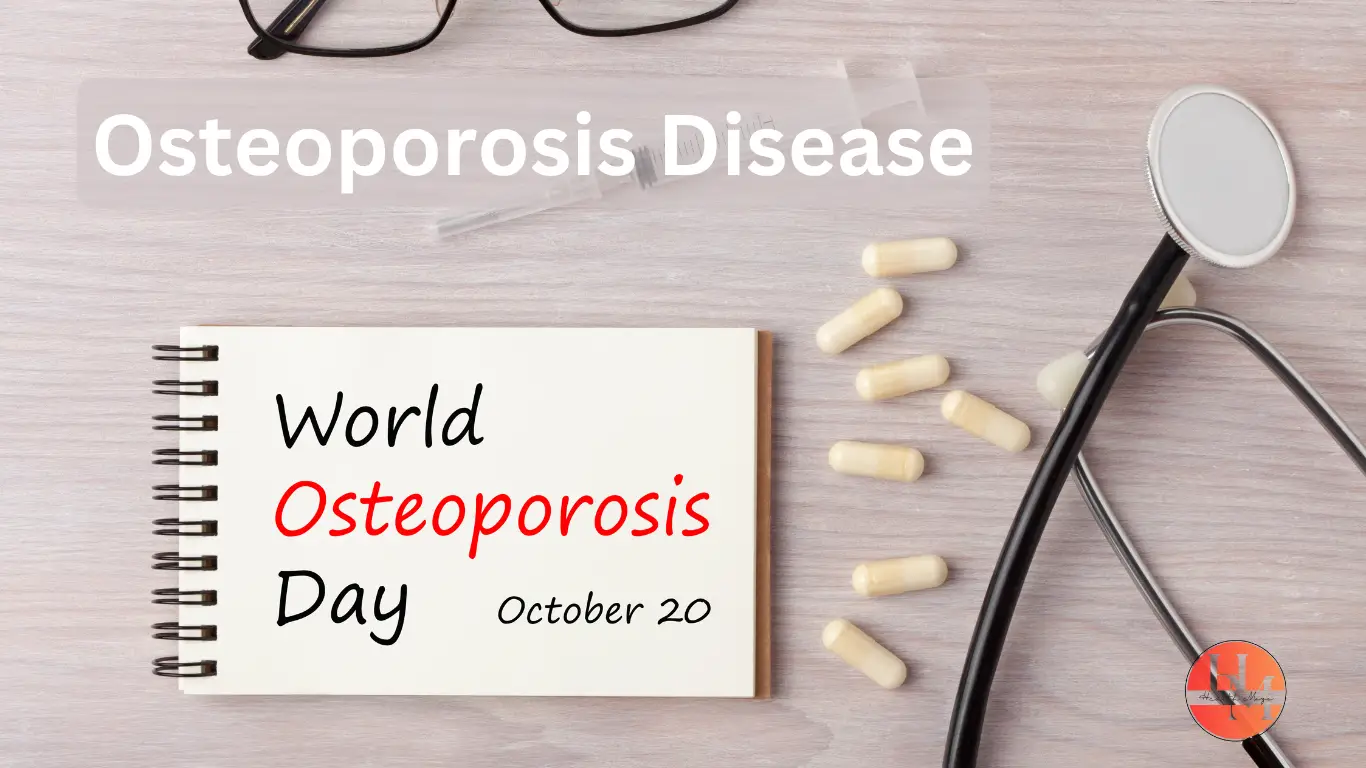World Osteoporosis Day
World Osteoporosis Day is celebrated annually on October 20. It’s a global awareness campaign aimed at increasing understanding and reducing the burden of osteoporosis, a disease characterized by weak, brittle bones. Understanding osteoporosis disease is very important for society.
- Raising Awareness: It helps spread knowledge about osteoporosis, its risk factors, and the importance of early diagnosis and prevention.
- Promoting Bone Health: It encourages individuals to take steps to maintain strong bones, such as regular exercise, a balanced diet, and avoiding excessive alcohol and smoking.
- Advocating for Support: It calls for increased support for research, education, and healthcare services related to osteoporosis.
Osteoporosis, often referred to as the “silent disease,” weakens bones and increases the risk of unexpected fractures. This condition affects millions of people, particularly older adults, and can significantly impact quality of life. In this post, we’ll explore the causes, symptoms, prevention, and treatment of osteoporosis, empowering you with the knowledge to protect your bone health.
Contents
What Is Osteoporosis Disease?
Osteoporosis Disease: It is a bone disease characterized by a decrease in bone density and quality. As bones become more porous and brittle, the risk of fractures, particularly in the hips, spine, and wrists, increases. Often, people don’t realize they have osteoporosis until a fracture occurs, earning it the title of the “silent thief.”
How Osteoporosis Develops
Bones are continually broken down and formed throughout life. When we’re younger, the body efficiently replaces old bone tissue with new, but as we age, the rate of bone loss outpaces the creation of new bone. This imbalance leads to osteoporosis.

Common Risk Factors for Osteoporosis
The following factors may increase your risk of developing osteoporosis disease:
- Age: Bone density decreases naturally as we age, making older adults more susceptible.
- Gender: Women face a higher risk, particularly after menopause, when the decline in estrogen levels makes them more susceptible.
- Genetics: A bad (based on osteoporosis) family history of osteoporosis can increase the risk.
- Low Calcium Intake: A diet lacking in calcium can weaken bones.
- Sedentary Lifestyle: Lack of physical activity reduces bone strength.
- Smoking and Excessive Alcohol: Both can interfere with bone health.
Signs and Symptoms of Osteoporosis Disease
Osteoporosis disease often goes unnoticed until a bone fracture occurs, but there are subtle signs to be aware of:
- Back Pain: Osteoporosis can cause the vertebrae to break or collapse.
- Loss of Height: Over time, compression fractures in the spine can cause a gradual and noticeable reduction in height, as the vertebrae weaken and collapse under pressure.
- Stooped Posture: Weakened bones in the spine can cause a hunched posture.
- Fractures: Fragile bones are more likely to break, even from minor falls or injuries.
Diagnosing Osteoporosis
If you’re concerned about osteoporosis, a doctor can perform a bone density test, called a DEXA scan (Dual-Energy X-ray Absorptiometry). This test measures bone mineral density and compares it to that of a healthy young adult, providing a T-score that indicates whether your bones are healthy, osteopenic (low bone mass), or osteoporotic.
Who Should Get Tested?
It’s especially important for the following groups to undergo bone density testing:
- Women over 65 and men over 70
- Postmenopausal women and men aged 50-69 with risk factors
- Individuals who have had fractures after age 50
- Individuals with certain medical conditions or who take medications that impact bone health are at an increased risk of bone-related issues, as these factors can weaken the bones over time.
Prevention of Osteoporosis
Taking proactive steps can help prevent osteoporosis and maintain strong bones throughout life. Here’s what you can do:
Increase Calcium Intake
Calcium is essential for maintaining bone health. Adults should aim for about 1,000-1,200 mg of calcium per day. Good sources of calcium include:
- Dairy products (milk, yogurt, cheese)
- Leafy green vegetables (kale, broccoli)
- Fortified foods (orange juice, cereals)
- Almonds and tofu
Get Enough Vitamin D
Vitamin D is fat-soluble, immune function, and helps your body absorb calcium effectively. Sun exposure is a natural way and free to get vitamin D, but we can also find it in:
- Fatty fish (salmon, mackerel)
- Fortified dairy products
- Egg yolks
- Vitamin D supplements available in the markets can be used on the recommendation of a doctor.
Engage in Weight-Bearing Exercises
Regular exercise strengthens bones and muscles. Focus on weight-bearing and muscle-strengthening activities such as:
- Walking or hiking
- Dancing
- Strength training with weights or resistance bands
- Yoga and Pilates
Avoid Smoking and Limit Alcohol
Smoking weakens bones, and excessive alcohol intake can interfere with your body’s ability to absorb calcium. Reducing or eliminating these habits can positively impact bone health.
Treatment Options for Osteoporosis
Empowered with the right treatment, you can strengthen your bones and reduce the risk of osteoporosis-related fractures. A personalized plan combining medication and lifestyle adjustments can help you live a more active and confident life.
Medications for Osteoporosis
There are medications that can make a difference. Your doctor will carefully select the best option to help strengthen your bones and reduce your risk of fractures
- Bisphosphonates: These medications slow bone loss and include options like alendronate (Fosamax) and risedronate (Actonel).
- Selective Estrogen Receptor Modulators (SERMs): Medications like raloxifene (Evista) mimic estrogen’s beneficial effects on bone density in postmenopausal women.
- Parathyroid Hormone Therapy: Teriparatide (Forteo) helps stimulate new bone growth in severe cases.
- Denosumab: This injection is prescribed for postmenopausal women at high risk of fractures.
Lifestyle Changes
In addition to medication, making healthy lifestyle choices can significantly improve bone strength and overall health. Key changes include:
- Balanced Diet: Ensure your meals are rich in calcium, vitamin D, and other nutrients that support bone health.
- Regular Exercise: Incorporate weight-bearing and resistance exercises to keep bones and muscles strong.
- Fall Prevention: Reduce the risk of falls by ensuring a safe living environment, using proper footwear, and maintaining good vision.
Living with Osteoporosis
Osteoporosis can affect daily life, especially after fractures. However, with the right approach, you can manage the condition and maintain a good quality of life.
Coping Strategies
- Adapt Your Home: Minimize fall hazards by securing rugs, installing handrails, and keeping rooms well-lit.
- Stay Active: Regular physical activity can reduce fracture risk and improve balance.
- Support Networks: Joining a support group or talking to others who have osteoporosis can help you navigate the challenges of the condition.
Bone Health Tips for Every Age
No matter your age, it’s never too late to take steps to protect your bones. Here are some key tips for each stage of life:
- Children and Teens: Focus on getting enough calcium and physical activity to build strong bones.
- Adults in Their 20s-40s: Continue building bone mass through exercise and a nutrient-rich diet.
- Older Adults: Prioritize fall prevention, maintain an active lifestyle, and get regular checkups to monitor bone health.
Conclusion:
Osteoporosis is a serious condition, but it can be managed and prevented with the right steps. By making healthy lifestyle choices, staying active, and seeking proper medical care, you can protect your bones and enjoy a higher quality of life as you age. Remember, it’s never too early or too late to take action for better bone health!

